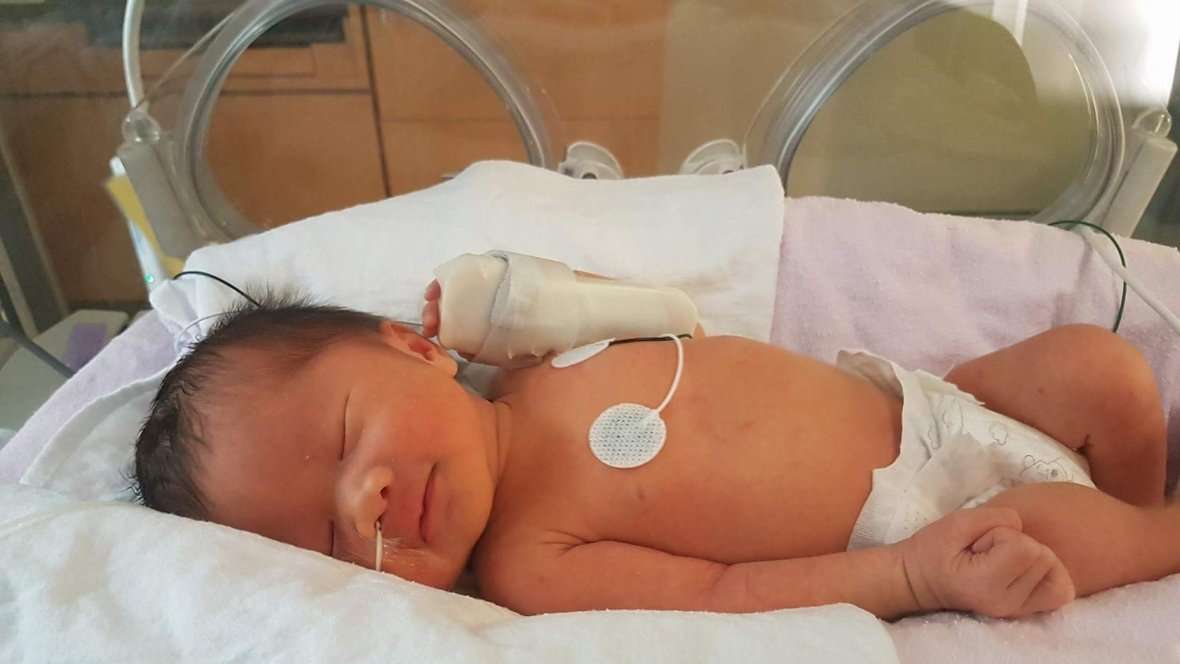For the first time in Canada, a team of surgeons has successfully performed in-utero surgery to repair a form of spina bifida, two Toronto hospitals say.
On Tuesday morning, Mount Sinai Hospital and the Hospital for Sick Children (SickKids) introduced Eiko Crisostomo, now almost three months old, and her parents at a news conference in Toronto.
Eiko, seen here in Mount Sinai Hospital's neonatal ICU, was delivered by caesarean section on Aug. 19 — more than two months after having surgery inside her mother's uterus. (Mount Sinai Hospital)
Eiko's parents, Romeo Crisostomo and Romeila Son, learned their baby had spina bifida at their 20-week ultrasound.
"Usually that's that time when you find out the gender," Son told reporters. "We were very excited to finally have a girl after having four boys."
But they were "devastated" to find out that their daughter would be born with a form of spina bifida called myelomeningocele, and would likely suffer brain damage and be in a wheelchair, she said. Son was especially worried her daughter would be in pain and exposed to repeated surgeries during her life.
Myelomeningocele affects about 120 to 150 babies in Canada every year, and occurs when the spinal column fails to close during fetal development.
The spinal cord comes out and is exposed to amniotic fluid, which becomes acidic, said Dr. Greg Ryan, head of Mount Sinai Hospital's neurosurgery team and one of two doctors who led Eiko's surgery.
Eiko was diagnosed with a form of spina bifida called myelomeningocele. Her spinal cord came out of the spinal column. This diagram shows what it looks like before and after in-utero surgery. (Mount Sinai Hospital )
The resulting damage to the spinal cord nervous system causes various degrees of paralysis. Many children need a permanent shunt to relieve pressure on their brains. According to Mount Sinai Hospital, fewer than half of children with spina bifida live independently when they become adults.
Son was determined to do whatever she could to help her baby and upon learning the in-utero procedure is performed in the U.S., was prepared to go.
But she met with doctors at Mount Sinai Hospital who had done in-utero surgeries before for other conditions, and they said they were prepared to offer it to her there.
"I wasn't scared," Son said on Tuesday. "I had zero doubt and 100 per cent confidence."
On June 4, a joint team of doctors and nurses from Mount Sinai and SickKids performed the surgery, when Eiko was at 25 weeks gestation. Her mother was given a general anesthetic, and the team inserted a needle through her abdomen to temporarily anesthetize and paralyze the fetus.
They then made incisions into the uterus to reach the fetus and close the skin over the spinal defect. The team also replaced amniotic fluid lost from the uterus during the procedure through a catheter — a critical step to keeping the fetus healthy.
More than two months later, on Aug. 19., Eiko was born by caesarean section.
Eiko's parents and four brothers are thrilled with the new addition to their family. (Mount Sinai Hospital)
Now almost three months old, Eiko's parents are hopeful about her future, as she smiled and wriggled in her father's arms while her mother spoke on Tuesday. At home, Eiko is "doing very normal baby things," Son said.
"Right now, her brain is stable, her legs are moving and kicking as you can see," Son said. "All of our prayers were answered. She's our little miracle."
The in-utero surgery does not guarantee Eiko will not be affected by spina bifida, but research done in the U.S. shows it improves her chances.
According to a U.S. study published in 2011, provided by Mount Sinai Hospital, brain malformations were reduced by one-third; children were half as likely to need walking aids or wheelchairs, and the need for brain shunts was reduced by half.
Since Eiko's surgery in June, the hospitals said Tuesday they had done the procedure three more times.
Son said she is happy that the in-utero procedure is now available to parents "on Canadian soil."

viacavour on November 14th, 2017 at 23:37 UTC »
My daughter had this surgery done two and a half years ago in Houston. Her defect is quite large, so it's unlikely she will ever walk without leg braces, and she does require intermittent cathing throughout the day, but she is undoubtedly better off than she would have been had we waited until she was born to have the surgery.
With this surgery, you ideally see motor and sensory improvements up to two levels of the spinal cord. For example, my daughter's defect starts at L3, but with the surgery, she will hopefully have improved neurological function up to the L5 level. And while this doesn't seem like much, it can mean the difference between walking independently and being wheelchair bound.
The most important benefit of the surgery, however, is the reduction in the rates of hydrocephalus, or swelling in the brain, which can be devastating. After the surgery, my daughter's hydrocephalus vastly improved, and although she still eventually required a shunt(drain) to relieve some excess pressure in her brain, she's going to lead a cognitively normal life, which was my biggest desire for her.
It's truly amazing what we can accomplish with modern medicine. One of the hospitals was even attempting this repair laparoscopically, which means not having to open the uterus all the way up. Not sure what progress they have made on it though.
Lastly, women of child bearing age, please take daily folic acid vitamins. A majority of cases of spina bifida can simply be prevented with just one or two pills a day.
8Bells on November 14th, 2017 at 22:40 UTC »
Drastically reduces the need for aides and surgical intervention later in life.
Cool!
DuncanD0nuts on November 14th, 2017 at 22:16 UTC »
Very cool read. I wish you the best baby Eiko